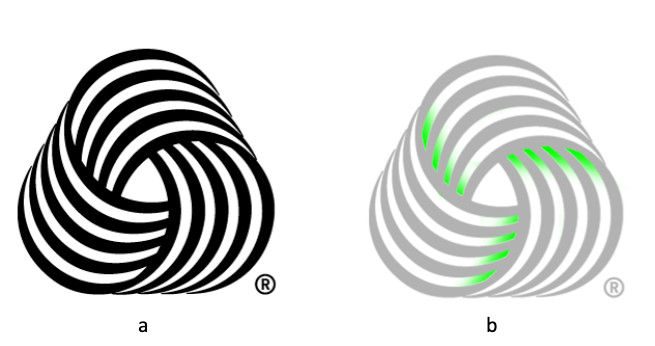“The photoreceptors in a particular receptive field do not simply stimulate the ganglion cell, but instead are arranged in what is called a center-surround organization. For example, light falling on the center of the receptive field might result in the corresponding photoreceptor stimulate the ganglion cell (an ON response). Light falling just on the surrounding ring of photoreceptors might inhibit the ganglion cells (an OFF response). This cell is an example of an ON-center, OFF-surround cell.”

There are two kinds of responses of ganglion cell in the center-surround organization when light falling on the receptive field: stimulate the ganglion cell, or inhibit it. If the ganglion cells in the center of receptive field are stimulated and peripheral ones are inhibited, the cell will be called ON-center, OFF-surround cell. As is shown in Figure 1, if light fall on the center of the cell, the sensitivity, or the firing rate of the whole cell will increase. But if light fall on the peripheral part of the cell, the sensitivity of the whole cell will decrease so that people may see a dark spot, even if the spot does not exist.

Figure2-a. Hermann Grid
Figure2-b. Explanation of Hermann Grid
One of the most classical examples of this is Hermann Grid illusion (Figure 2-a). When viewing the Hermann Grid, people will see the faint dark spots that appear at the intersections of the white lines. In Figure 2-b, compared to cell 1, cell 2 on the intersection has more OFF cells activated (marked with rad minus), which means more inhibition on cell 2. So it is less sensitive than cell 1. Therefore, we see dark spot at the intersection. Actually, if you look carefully at the grid, you probably see very faint dark lines between every black square, which is extracted below (Figure 3-a). On the center of the white line, more surrounding photoreceptors (OFF cells) are stimulated by light, so that more center photoreceptors are inhibited from perceiving the light.

The function of center-surround organization can also reflect on some LOGO design. With single color, they produce ingenious chiaroscuro. Take the example of Figure 4, the logo of Woolmark. When looking at the logo, you might notice that the space between the lines is not pure white. Certain parts of them seem little brighter, which are marked with green on Figure 4-b. That’s because these areas are at the end of the gaps. There will be less light falling on the ganglion cell, and the OFF-surround cells do not produce too much inhibition. So, we feel these areas are brighter, just like there are some light leaks from the inside of the wool ball.

Sources:
Grid illusion: https://en.wikipedia.org/wiki/Grid_illusion
Making Sense of the Hermann Grid Illusion: http://www.rosslab.neurobio.pitt.edu/making-sense-of-the-hermann-grid-illusion/
